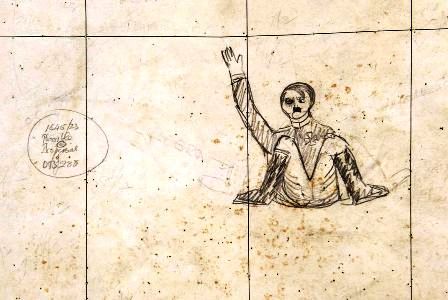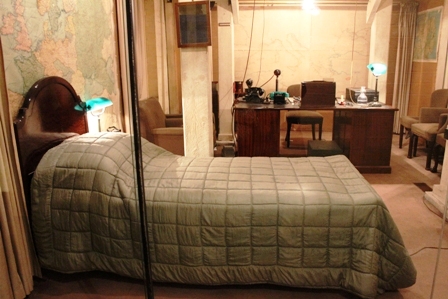A BRITISH BULLDOG'S LAIR
Churchill's Secret Wartime Office
By Margaret Deefholts
(For Travel Writers' Tales )
Bomb on display in Museum foyer
Wartime posters
“We shall fight on the beaches, we shall fight on the landing grounds, we shall fight in the fields and in the streets, we shall fight in the hills; we shall never surrender!” The voice on the reception room's speaker system echoes down the years, evoking an image of Winston Churchill, cigar in hand, pugnacious and defiant, leading his country to victory despite all odds in Britain's ‘darkest hours' of World War II.
More than seventy-five years after those words were spoken, I am in an underground labyrinth of offices, conference rooms, and living quarters that functioned as the Cabinet War Rooms from 1939 to 1945. Known today as the Churchill War Museum in the heart of London's Whitehall area, it was the nucleus of wartime tactical planning and communication. A hideout cloaked in deepest secrecy.
Cabinet Meeting Room |
Chief of Staff's Conference Room |
It is a strange feeling to walk these corridors of history, to peer into rooms that were once peopled by the men and women who held the weight of Britain's destiny in their hands. In the Cabinet meeting room, where Churchill, imperious and irascible, chaired meetings with Navy, Army and Air Force Chiefs of Staff, one can imagine the tension lying as thick as Churchill's cigar smoke curling up to the ceiling.
Churchill was Britain's knight in shining armour—albeit a rather rotund one—as he led his country to a triumphant, jubilant victory in 1945. Born in 1874 at Blenheim Palace, his family's ancestral home, he saw action in South Africa's Boer War, and in Afghanistan. As First Lord of the Admiralty during World War I he was roundly excoriated for the debacle of Gallipoli and resigned shortly thereafter. However, he was back at the helm in 1940, declaring that he could offer the country nothing but his “blood, toil, tears and sweat.”
I can't but wonder about daily life in this hidden underground basement, a mere 30 feet below the surface. The sounds of bomb blasts, the shrilling of air raid warnings and ambulance sirens must have been unnerving. By some extraordinary stroke of Fate, the Cabinet War Rooms never received a direct hit, although an area in the back of the adjacent Treasury building suffered some damage. Had it been otherwise, the loss of England's Prime Minister, his Cabinet and the heads of the country's armed forces, all of whom met here regularly, would have changed the course of history. An unimaginable, indeed unthinkable, outcome! As it was, nobody had a clue as to what was transpiring below ground in the very heart of wartime London.
The Museum's corridors are flanked by administrative offices which were once alive with activity—stenographers at typewriters, clerks poring over ledgers, cabinet ministers at meetings, and military big-wigs studying the deployment of military and marine units as marked with coloured pins on detailed wall maps. Churchill presided over all this, brandy snifter at his elbow, and stogie at hand, dictating at rat-a-tat speed to his quaking secretaries, and delivering thundering speeches over microphones set up on his desk.
GHQ Home Forces Office |
Typing Pool |
Map Room with battery of phones connected directly to different armed services' headquarters in London. Nicknamed the “Beauty Chorus” |
|
BBC Broadcasting equipment |
 Hitler cartoon |
Aide-de-Camp's bedroom |
Cabinet Secretary, Sir Edward Bridge's Room |
Emergency office and sleeping accommodation
As far as living quarters went, senior military brass and Cabinet officials were accommodated in small but well- furnished bedrooms, while lesser mortals had to make do with utilitarian bunk beds with thin mattresses and blankets. Stenographers and clerical staff slept in the “Dock” several floors below, and had to trek upstairs for showers or use of the toilet facilities. Churchill's own study-cum-bedroom is luxurious by these standards but he reputedly only slept overnight here on three occasions during the entire course of the war.
 Churchill's bedroom-cum-office Churchill's bedroom-cum-office |
Desk in Churchill's bedroom |
Churchills' kitchen |
Churchills' dining room |
Clementine Churchill's Room
VE Day on May 8th 1945 marked the end of the war, and deliriously joyous crowds thronged the square in front of Buckingham Palace. Along with the Royal Family, a beaming Churchill stood on the palace balcony, waving in acknowledgement of the chant, “Winnie! Winnie! Winnie!” .
For the stubborn old British bulldog, this was indeed his very own “finest hour”.
________________________________________
Travel Writers' Tales is an independent travel article syndicate that offers professionally written travel articles to newspaper editors and publishers. To check out more, visit www.travelwriterstales.com
IF YOU GO:
Information: https://www.iwm.org.uk/visits/churchill-war-rooms
PHOTOS: By Margaret Deefholts (unless otherwise attributed)